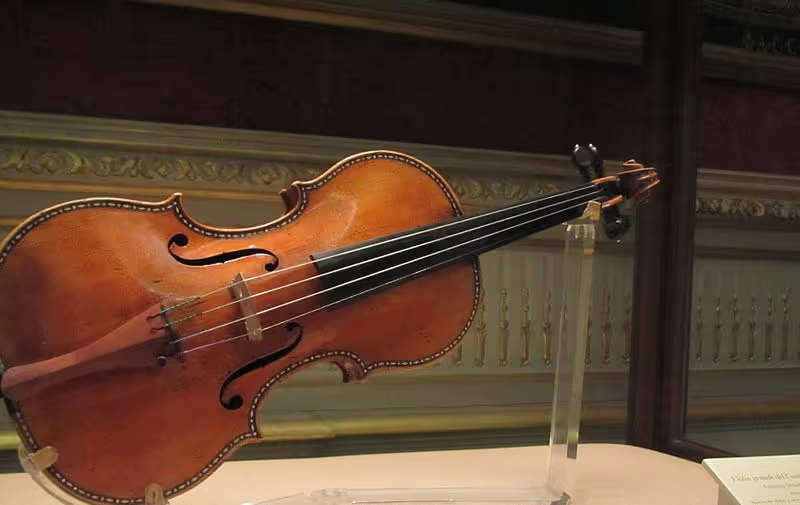These are the top 4 most expensive instruments in the world

Instruments as an alternative investment are often new territory, especially for less music-savvy investors. But given the trend towards tangible asset investments as inflation protection and their relative independence from capital markets, it may be worthwhile for laymen to invest in rare stringed instruments, guitars or grand pianos. Learn more about suitable music investments and their return prospects.
Cultural assets against economic downturn
In times of economic policy uncertainty, low interest rates and turbulent stock markets, tangible assets are very popular for portfolio diversification. Real estate, art, classic cars or fine watches are attracting ever larger buyers who want to diversify their capital as broadly as possible and invest in an inflation-proof manner. In the area of alternative investments, instruments still often live in the shadows. They too have a very low correlation with all other asset classes, low volatility and little potential for loss in times of crisis. There are also USPs, such as the actual “mobility” of the instrument, the musical return and the comparatively low additional costs.
And, of course, an attractive return perspective: According to the relevant for stringed instruments “Fox tax“have high-quality stringed instruments in the past Thirty years, an average increase in value of over six percent p.a. recorded. Particularly exposed individual pieces are often significantly higher. Sought-after instruments such as Stradivari violins sometimes change hands at unbelievable conditions and are regularly auctioned off for millions of dollars.
But instruments from slightly less well-known luthiers also generate high returns. For example, the violins by Italian Domenico Montagnana: While his instruments in the Fuchs Tax from 1975 were still estimated at 60,000 to 75,000 euros, In 2017, the price range was 550,000 to 1,200,000 euros. This corresponds to a total return of 1,500 percent over 42 years or a good 35 percent p.a.
As an “extra”, instrument investors also receive an “priceless” musical return. Exclusive instruments are used, for example, by German Music Life Foundation awarded in trust to young, talented musicians. In return, the patrons enjoy the sound of their instruments on big stages.
The top 4 most valuable instruments
The manufacturer and history of an instrument are decisive for the value and increase in value. Distinctive instruments by renowned artists, which were played by well-known musicians, are considered particularly valuable due to the ever scarce supply and rare auctions. Of course, there are also expensive guitars, pianos or flutes. But stringed instruments and bows from renowned violin makers have been selling at the highest prices for years.
Antonio Stradivari produced more than a thousand instruments up to the year of his death in 1737, and a few hundred his neighbor Giuseppe Guarneri del Gesù. Of these, around 600 violins, 60 cellos and 12 violas, which have a stamp with the initials Stradivari on the inside, and a good 140 violins from Guarneri del Gesù's workshop are still preserved. The cult of 300-year-old violins has driven prices into the millions in recent decades. Four of the most expensive instruments in the world are currently:
1 viola “Macdonald”, Stradivarius
In 2014, Sotheby's offered a viola for the record sum of the equivalent of 33 million euros - but did not sell it. The viola, made from spruce and maple wood in 1719, was known as the “Macdonald Viola” - named after a previous owner, Godfrey Bosville, Baron Macdonald III, who bought the instrument around 1820. According to Sotheby's, the viola with the famous Stradivari livery is still in perfect condition.
If a lover had really put 33 million euros on the table, this would have been a new record for a musical instrument.
2 violins “Vieuxtemps”, Guarneri
The most expensive violin in the world is currently the “Vieuxtemps” Guarneri del Gesù from 1741, which sold in 2013 for allegedly 16 million dollars. It is currently played by Anne Akiko Meyers, to whom it has been made available for life.
3 violins “Lady Blunt”, Stradivarius
The famous Stradivari violin “Lady Blunt” is in third place: It was sold in June 2011 for 15.8 million dollars. The violin was owned by Lady Anne Blunt, the granddaughter of the famous English poet Lord Byron, for 30 years. Other owners included legendary Parisian violin maker Jean Baptiste Vuillaume, collectors Richard Bennett, Baron Knoop and Sam Bloomfield, and the Nippon Music Foundation. One of the special features of the violin is that it is in excellent condition.
4 cello “Mara”, Stradivarius
The most expensive cello in the world was already a myth after it left Antonio Stradivari's workbench in 1711. But she became a legend on the night of July 12, 1963, when the musician Amadeo Baldovino boarded the ferry to Buenos Aires in Montevideo. When it hit a sunken wreck and caught fire, Baldovino jumped into the water with the cello case, but lost sight of it. Later, however, “Mara” actually reappeared in individual parts and was carefully reconstructed. Its value is currently estimated at over ten million dollars.
Instrument investments for beginners
But it doesn't always have to be in the millions. Experts assume that investors can buy stringed instruments of a quality that classifies them as an investment starting at around 30,000 euros.
However, investors should be aware that instruments are not a liquid asset class, do not guarantee an increase in value, and reselling instruments is often lengthy. Aspects such as the insurance, storage and maintenance of violins, violas or cellos must also be considered.
Beginners should therefore be better off investing in instruments digitized real value shares consider it as an attractive and value-stable portfolio addition. In this way, you become a partner in a high-quality instrument curated by experts for as little as 500 euros and benefit from potential increases in value just like an owner.



